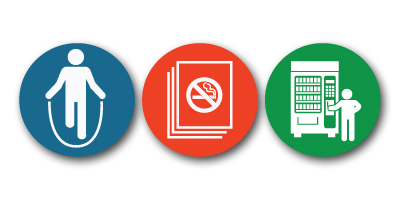This page is a historical archive and is no longer maintained.
For current information, please visit http://www.cdc.gov/media/
Press Release
For Immediate Release:Monday, August 26, 2013
Contact:
Media Relations
(404) 639-3286
CDC releases 2012 School Health Policies and Practices Study results
School districts show positive trends

Infographic: "Encouraging trends in nation’s school policies on nutrition, physical education/ physical activity, and tobacco"
Entire Infographic [322KB]
School districts nationwide are showing improvements in measures related to nutritional policies, physical education and tobacco policies, according to the 2012 School Health Policies and Practices Study (SHPPS). SHPPS is the largest and most comprehensive survey to assess school health policies.
"Schools play a critical role in the health and well-being of our youth," said CDC Director Tom Frieden, M.D., M.P.H. "Good news for students and parents – more students have access to healthy food, better physical fitness activities through initiatives such as ‘Let’s Move,’ and campuses that are completely tobacco free."
Key findings include:
Nutrition:- The percentage of school districts that allowed soft drink companies to advertise soft drinks on school grounds decreased from 46.6 percent in 2006 to 33.5 percent in 2012.
- Between 2006 and 2012, the percentage of districts that required schools to prohibit offering junk food in vending machines increased from 29.8 percent to 43.4 percent.
- Between 2006 and 2012, the percentage of districts with food procurement contracts that addressed nutritional standards for foods that can be purchased separately from the school breakfast or lunch increased from 55.1 percent to 73.5 percent.
- Between 2000 and 2012, the percentage of districts that made information available to families on the nutrition and caloric content of foods available to students increased from 35.3 percent to 52.7 percent.
Physical education/physical activity:
- The percentage of school districts that required elementary schools to teach physical education increased from 82.6 percent in 2000 to 93.6 percent in 2012.
- More than half of school districts (61.6 percent) had a formal agreement, such as a memorandum of agreement or understanding, between the school district and another public or private entity for shared use of school or community property. Among those districts, more than half had agreements with a local youth organization (e.g., the YMCA, Boys or Girls Clubs, or the Boy Scouts or Girl Scouts) or a local parks or recreation department.
Tobacco:
- The percentage of districts with policies that prohibited all tobacco use during any school-related activity increased from 46.7 percent in 2000 to 67.5 percent in 2012.
SHPPS is a national survey periodically conducted to assess school health policies and practices at the state, district, school, and classroom levels. SHPPS assesses the characteristics of eight components of school health: health education, physical education and activity, health services, mental health and social services, nutrition services, healthy and safe school environment, faculty and staff health promotion, and family and community involvement.
SHPPS was conducted at all levels in 1994, 2000, and 2006. The 2012 study collected data at the state and district levels only. The school- and classroom-level data from SHPPS will be collected in 2014 and released in 2015.
For more information, go to www.cdc.gov/shpps. Â Â
Get email updates
To receive email updates about this page, enter your email address:
Contact Us:
- Centers for Disease Control and Prevention
1600 Clifton Rd
Atlanta, GA 30333 - 800-CDC-INFO
(800-232-4636)
TTY: (888) 232-6348 - Contact CDC–INFO